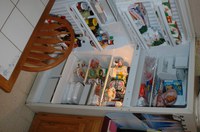Prairie Fare: Is Any Food in Your Fridge Reaching Antique Status?
(Click an image below to view a high-resolution image that can be downloaded)
By Julie Garden-Robinson, Food and Nutrition Specialist
NDSU Extension Service
“My brother cleaned out his refrigerator after listening to you,” my husband told me.
“What do you mean?” I responded. My brother-in-law lives in California. I didn’t remember being “the bossy sister-in-law” or food police lately.
“He was listening to a radio program streamed on the Internet this morning,” my husband responded. “You were talking to a local station about how long food can be stored in the refrigerator.”
Sometimes I forget what a technological world we inhabit.
The radio program hosts and I were discussing how long food in your refrigerator remains safe to eat. We also talked about food quality. The previous week, the hosts had a call-in program where people revealed the oldest items they had in their refrigerator.
Some of the items the callers mentioned seemed to be approaching “antique” status. Someone mentioned eating 5-year-old homemade horseradish. The suggested shelf life for horseradish is a few months, partly because the flavor decreases fairly quickly.
Most of us have some items inhabiting our refrigerator that probably have overstayed their welcome. However, if you are like me, you don’t like to waste food.
Let’s take a little tour of your fridge, if you happen to be at home. Do you have ketchup, mayonnaise, eggs, pickles, milk or perhaps a pound of ground beef? Did you buy a particular kind of salad dressing for a party last winter and it stands at attention each time you open the refrigerator door?
I think I surprised the radio hosts when I told them opened, refrigerated condiments have a typical “maximum shelf life” of three to four months. Eggs usually last three to five weeks past the “sell by” date. By the way, if you hard-cook the eggs, the shelf life decreases.
Refrigerated jars of pickles may last up to a year after opening, although some sources are more conservative at four months.
Milk generally lasts a week beyond the date on the carton, but the safety and quality of the milk depend on how long it was at room temperature during dinner. Sniff it to see if it has an off odor. Ground meat should be used within a couple of days of purchase or frozen, and roasts or other larger cuts of meat should be used within about five days or frozen.
Be aware of food label lingo to avoid having to toss food. The words “expiration date” only apply to certain foods. Infant formula has a true expiration date, so do not use it beyond the date because of potential losses in nutrition and/or safety.
“Sell by” dates inform the store how long to display the foods. We typically can use the food beyond the date. Most foods carry quality dates such as “best if used by” dates, and usually we can use the product for a while beyond that date.
Keep a permanent marker near your fridge and jot down on the package label the date you opened the product. Some people put a “throw out” date on the package label. If you find that you just can’t use up the bargain-size bottle of ketchup within a few months, buy a smaller bottle or find a recipe that uses ketchup. Sometimes the larger containers aren’t the best deal.
Be sure to keep your refrigerator at 40 degrees, or a little lower, to keep your food cold without freezing it.
If you are wondering what to do with fresh tomatoes and peppers from your garden, try making your own ketchup with this recipe adapted from the U.S. Department of Agriculture’s “Complete Guide to Home Canning.” For best quality, use home-canned goods within one year of canning. For more information, visit the NDSU Extension Service’s website at https://www.ag.ndsu.edu/food and click on “Food Preservation.”
Country Western Ketchup (Home-canned)
24 pounds ripe tomatoes
5 chili peppers, sliced and seeded
1/4 c. salt
2 2/3 c. vinegar (5 percent)
1 1/4 c. sugar
1/2 tsp. ground red pepper (cayenne)
4 tsp. paprika
4 tsp. whole allspice
4 tsp. dry mustard
1 Tbsp. whole peppercorns
1 tsp. mustard seeds
1 Tbsp. bay leaves
Makes 6 to 7 pints
Wash tomatoes. Dip in boiling water for 30 to 60 seconds or until skins split. Dip in cold water. Slip off skins and remove cores. Quarter tomatoes into 4-gallon stock pot or a large kettle. Add chili peppers and red pepper. Bring to boil and simmer 20 minutes, uncovered. Combine spices in a spice bag and add to vinegar in a 2-quart saucepan. Bring to boil. Turn off heat and let stand until tomato mixture has been cooked 20 minutes. Then remove spice bag and combine vinegar and tomato mixture. Boil about 30 minutes. Put boiled mixture through a food mill or sieve. Return to pot. Add sugar and salt, boil gently and stir frequently until volume is reduced by one-half or until mixture mounds up on spoon without separation. Fill pint jars, leaving 1/8 inch head space. Adjust lids and process in a boiling water-bath canner, adjusting for altitude as noted: 15 minutes (1,000 to 3,000 feet), 20 minutes (1,001 to 6,000 feet) or 25 minutes (above 6,000 feet).
(Julie Garden-Robinson, Ph.D., R.D., L.R.D., is a North Dakota State University Extension Service food and nutrition specialist and professor in the Department of Health, Nutrition and Exercise Sciences.)
NDSU Agriculture Communication - Aug. 17, 2017
| Source: | Julie Garden-Robinson, 701-231-7187, julie.garden-robinson@ndsu.edu |
|---|---|
| Editor: | Ellen Crawford, 701-231-5391, ellen.crawford@ndsu.edu |



